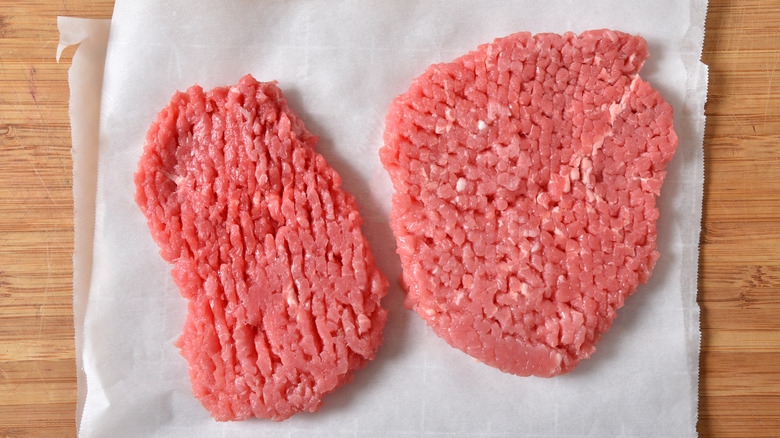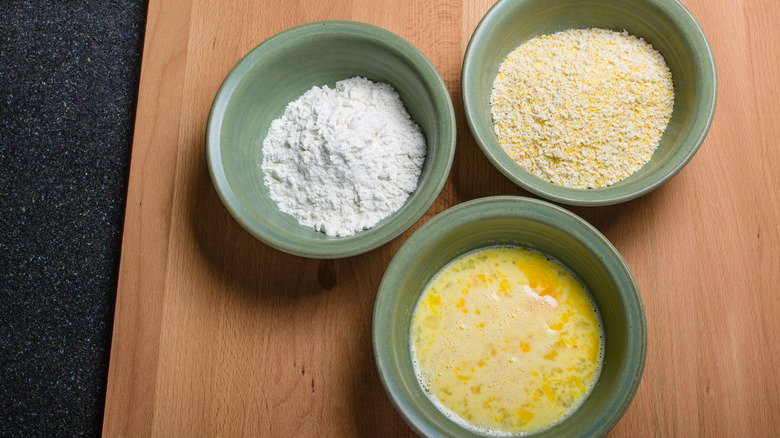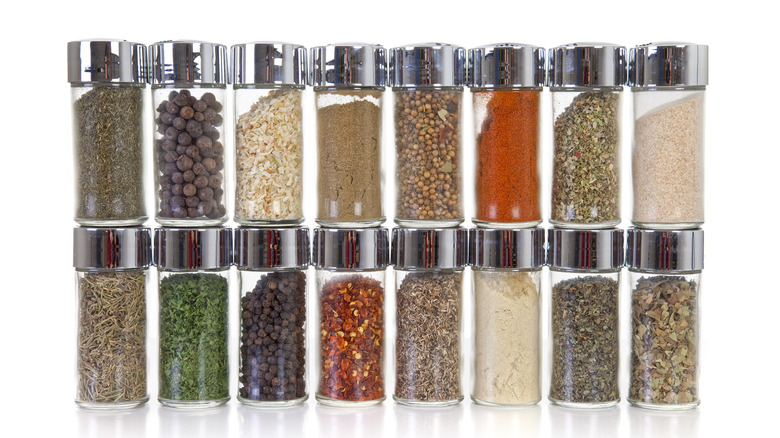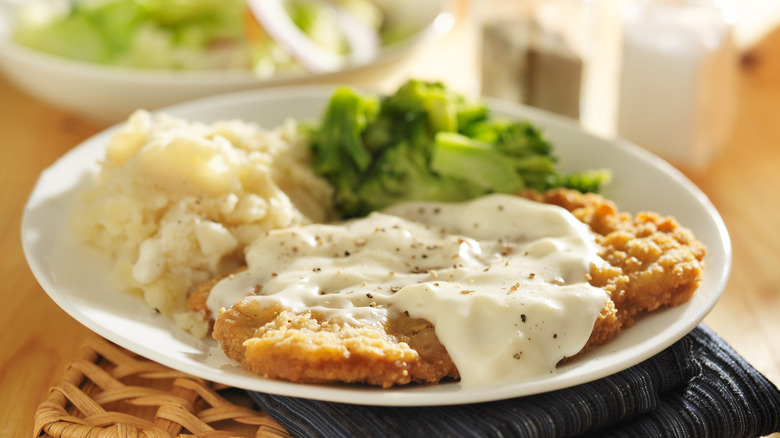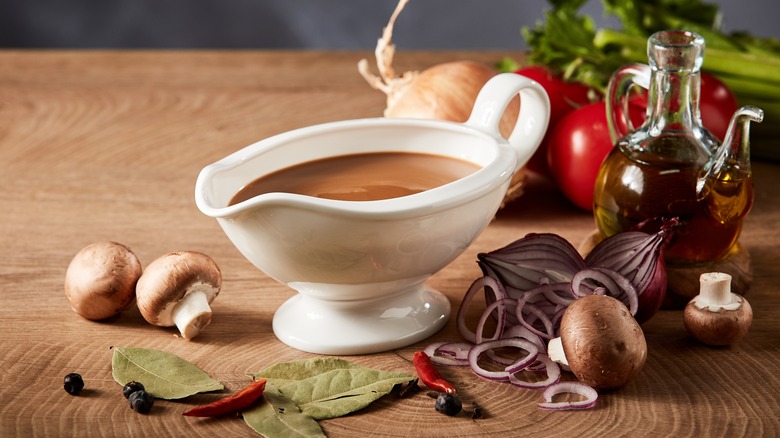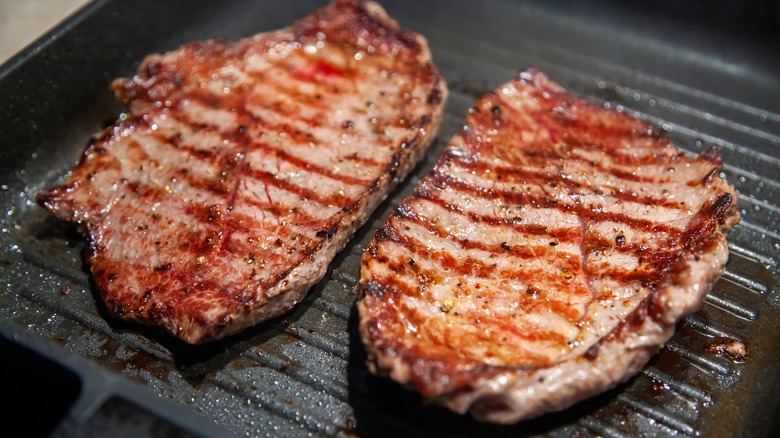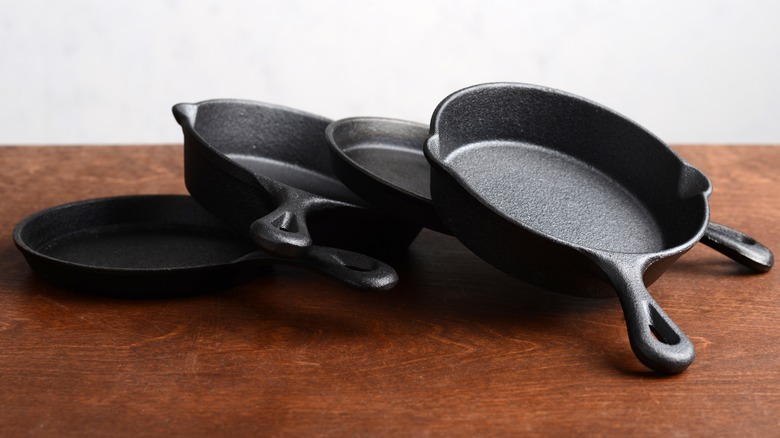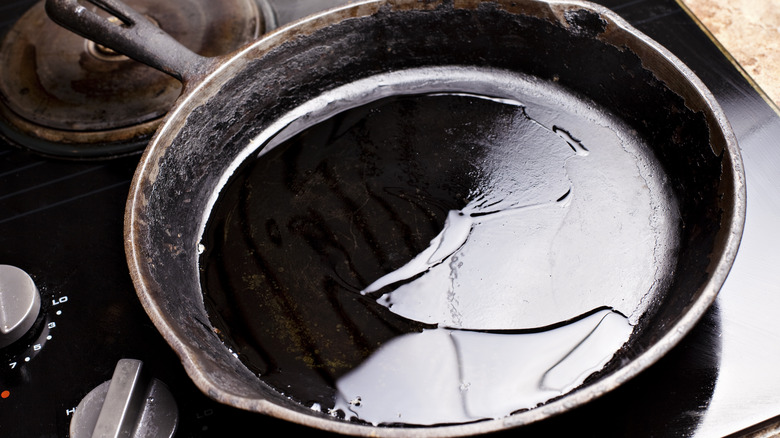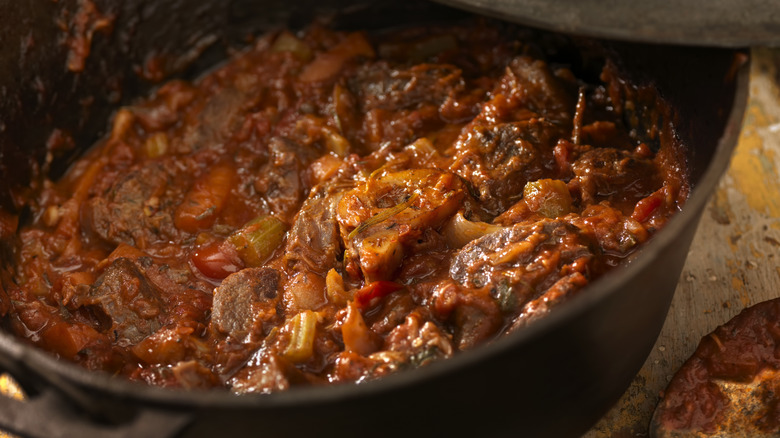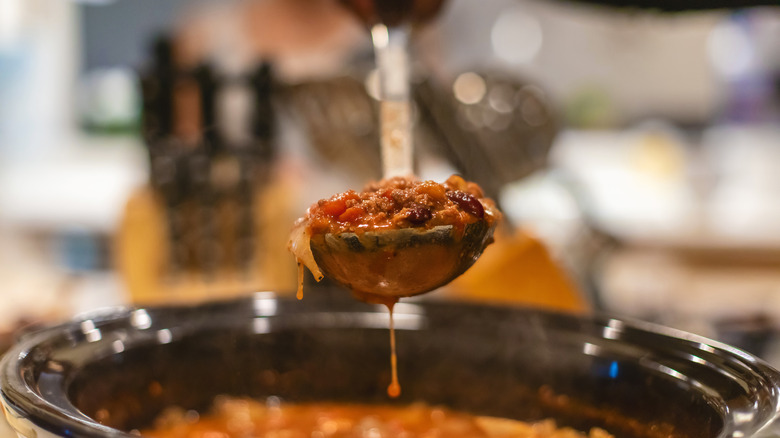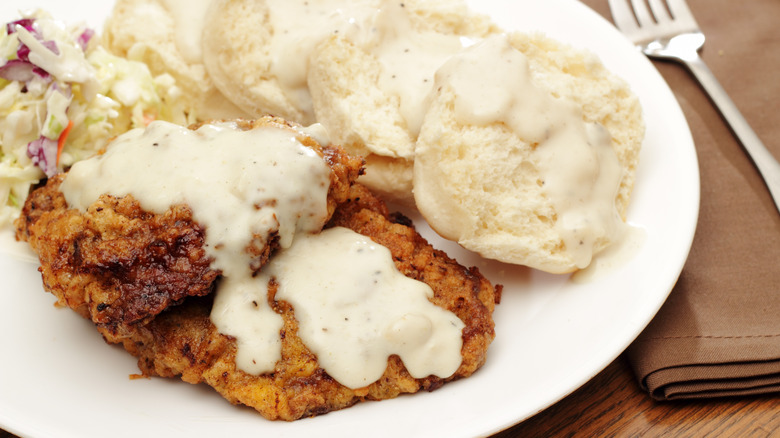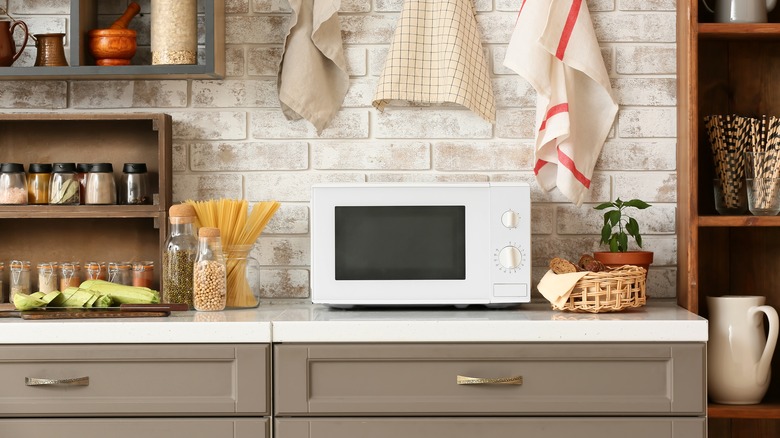Mistakes Everyone Makes When Cooking Cube Steak
Once a staple of home kitchens, cube steak has been fading in popularity for quite some time. We spoke with some expert chefs to understand why this type of cut is being passed up for other options. "I think the newer generation may not get it," acknowledges executive chef Bill Rosenberg of Bstro38 NYC. "Everyone now is used to the first cuts, i.e. NY striploin, filet mignon, ribeye, so a piece of meat that is cubed or flattened to tenderize is not always on the radar."
In his answer, Rosenberg defines a cube steak as a less expensive cut of beef — usually round or top sirloin — that is pounded with a textured mallet to pre-tenderize the meat, leaving little pinpricks or indentations on the surface. As for why this method is desirable, Katie Flannery, COO of Flannery Beef, points out that "Muscles are made up of bunches of fibers. In a cut like the bottom round, you will have much thicker, more visible muscle fibers. The cubing process helps to increase the tenderness of the final steak by simply creating small cuts along the muscle fibers."
Despite the end goal being tenderness, the reality is that all too often, cube steak ends up being tough or dry. Luckily, with the right approach, this cut can be absolutely delicious. Here are the mistakes everyone makes with cube steak, as well as our top tips to avoid making them so that your cube steak turns out tender and flavorful every time.
Neglecting to coat with flour or breadcrumbs
The first step to cube steak mastery is to forget what you think you know about cooking a steak. Instead of directly placing the naked steak into a hot pan, cube steak is happiest when breaded, lending moisture to the finished steak, according to Michael Tsarnas, executive chef of Gabriella's Italian Steakhouse in New Jersey. If you're using a breadcrumb coating, you'll start with an egg wash, which chef Bin Lu of Blue Rock in Virginia's Rappahannock County notes helps "form a seal around the steak," trapping in the coveted moisture.
Cube steaks can either be coated in seasoned flour or in breadcrumbs; the coating you choose depends entirely on the texture of the finished product you're hoping to achieve, Flannery says. "If preparing a recipe that pairs cube steak with a gravy," she explains, "you'll want to coat the steak with flour first, whereas if you are doing a chicken fried steak recipe, you would use breadcrumbs."
Rosenberg notes that he prefers to begin with seasoned flour, "like your good old fried chicken flour." This preparation begins with a buttermilk soak, followed by a double dip in a seasoned flour dredge. This extra layer of flour is crucial to create a crispy, flavorful coating.
Seasoning too minimally
Per its name, it's no surprise that seasoned flour must be well-seasoned. Rosenberg likes using Old Bay seasoning, Tabasco, salt, and pepper to flavor his cube steak, but the sky's the limit. "Because of the coating, there's more leeway to get creative with flavors," says Lu. "There's no reason not to use spices, seasonings, and whatever else in your pantry that piques your interest." This might seem odd considering the less-is-more mentality of most steak recipes, which frequently call for just salt and pepper. But as Flannery notes, "different cuts have vastly different 'personality traits.'"
"You need to know what you are working with in order to prepare the steak in a way that lets it shine," she says. "A cut like ribeye, especially if sourced from USDA Prime grade, is going to have such a high level of tenderness and flavor that the best method is to go the 'less is more' route, and keep the seasoning simple in order to let the natural flavor and tenderness of the steak come through. If you were to apply the same seasoning/cooking method to a cut that didn't have the inherent tenderness/flavor, you would end up with a bland, tough, and overall unenjoyable eating experience."
So feel free to pull out all the stops when seasoning your cube steak, such as by adding heat with cayenne pepper, aromatic richness with rosemary, or depth with curry powder. Let your taste buds be your guide, and you won't be disappointed.
Disguising flaws with gravy
Cube steak and gravy go hand in hand, especially when you consider that one of the most popular ways to cook and enjoy the cut is by making chicken fried steak (which contains zero chicken). Indeed, some people might argue the best part of cube steak is soaking bread in the gravy served with it. Still, it's worth noting that gravy can also mask all manner of flaws.
But what's the point of eating shoe leather just to enjoy the sauce? Rather than disguising the texture of cube steak by covering it with gravy, our experts tout the benefits of treating the steak well — even if that means you never serve it with gravy. According to Rosenberg, a well-made cube steak can be part of a delicious meal with or without sauce. "I think if seasoned correctly you can get away without the gravy," he says.
Lu agrees, noting that while gravy isn't necessary, the steak "does need to be well seasoned and cooked correctly" to give the cut of meat the treatment it deserves. Tsarnas concurs and states, "Anything that is cooked and seasoned properly does not need a gravy to taste good." Nevertheless, he adds that "cube steak is traditionally served with gravy."
Neglecting the gravy
Just because cube steak can be enjoyed without gravy that doesn't mean it should. "Cube steak doesn't have to be paired with a gravy to taste good, but it does need some help in the flavor department (and gravy does an excellent job)," says Flannery. She notes that to counteract the lack of marbling in a cube steak, "you need a recipe that will impart both flavor and moisture, which is why gravy is such a perfect pairing as it provides both those key aspects."
Plus, it's just plain delicious. "Why stray from tradition?" says Rosenberg. "I think the gravy kind of rounds things out." He makes his recipe in the same pan he uses to cook the steak, draining off excess fat. He caramelizes onions in the remaining lard, adding a touch of garlic, a few mushrooms, a splash of marsala wine, and some veal demi-glace. Lu, meanwhile, prefers a classic salt and pepper sausage gravy, "made with roux and preferably sausage fat."
Flannery, too, loves pairing this simple white gravy with cube steak. "After browning the cube steaks in a pan, throw a bit of flour into the pan with some salt and pepper," she suggests. "Whisk on medium heat till it thickens, then turn heat to low and add some milk." The recipe isn't just easy, she says; it also boasts "a great 'comfort food' vibe."
Cooking cube steaks to the wrong temperature
One essential element of getting the perfect cube steak texture is cooking it to the right internal temperature. Seeing as it's quite lean and has a tendency to become chewy, Flannery recommends aiming for a rare doneness, at 120 degrees Fahrenheit. As she explains, the assumption is that the steak will gain a few extra degrees as it rests, meaning you ultimately have an internal temperature of around 125 degrees Fahrenheit. The result is a steak that's rosy and red inside and definitely won't dry out.
Tsarnas, meanwhile, prefers to cook his steaks a bit more, noting that "medium-rare is perfect" for a cube steak. "If cooked past medium," he cautions, "the meat will become dry and tough." Lu is an outlier of the group, noting that cube steaks are "best well done."
What's a home cook to do? Consider the texture you want your finished steak to have. If a crispy exterior is more important to you than a tender, juicy interior, consider cooking it more. On the other hand, if you want a pink hue and don't mind a lighter crust, veer rarer. Or, you could split the difference, as Rosenberg does, shooting for medium, which gives you the best inner and outer textures. "It provides you with a great crust and nice tender chew," he says.
Using the wrong pan to cook your cube steaks
Not all pans are created alike, and when it comes to cooking cube steak to perfection, choosing the right one is crucial. Nonstick? Stainless? No; our experts all agree that cast iron is the only way to go. Rosenberg notes that seasoned cast iron provides an even high heat to obtain the perfect caramelized exterior on the steak. Tsarnas agrees: "Cooking cube steak in a cast-iron pan is ideal because cast-iron heats very evenly and retains heat extremely well allowing you to cook quickly at a high heat," he explains.
Heat retention is also at the heart of Lu's recommendation — a third vote for cast iron. "You're likely going to be frying in a good bit of oil and want to maintain temperature," he says. Cast iron conducts heat and holds it well, meaning that you can take advantage of any residual heat to prepare the base for your gravy. Plus the sturdy pan is ideal for shallow-frying, the cooking method our experts love most for this particular cut.
Cooking cube steak in too little fat
Unlike other steaks, cube steaks are best off being shallow fried, which means starting with about 2 inches of fat in the pan. It may look like a lot, but don't be fazed. Not only does the quantity of oil you fry in have little effect on the amount that ends up in the food (this has far more to do with the duration and temperature of cooking), but according to Rosenberg, it leads you to the ideal result: "a good crunchy crust" on both sides of the steak. As for which fat to use, cooking oil is certainly fine, but for Rosenberg, it's impossible to beat the rich flavor of lard.
While most of our experts prefer to shallow fry their cube steaks — which is far easier for home cooks "because it's less prone to mess and isn't as involved as deep frying," Lu notes — there is an argument for breaking out the big guns and deep-frying. "I would also say this one depends on [the] recipe," says Flannery. "A breaded chicken fried style cube steak can be done either in a shallow or a deep fry, whereas a flour dredged cube steak only needs a shallow fry."
Not considering making stew
Although cube steak tastes great when shallow-fried, don't forget that as a tougher cut, it can also be slow-cooked. "Cube steaks take very well to a good braise," says Rosenberg. "About 45 minutes, and you have tender goodness, a great inexpensive meal for a weekday." Depending on the flavor profile you prefer, this could mean simmering cube steaks in a bit of wine for a quicker take on beef bourguignon or sprinkling the cube steaks with barbacoa seasoning to pave the way for a quick and easy copycat Chipotle bowl.
Lu reminds us that cube steak doesn't have quite the same connective tissues to break down in the way that other stewing cuts do, which means that while slow-cooking may make it more tender, you're unlikely to get the same fall-apart consistency as with other cuts of beef more frequently used in braises and stews.
"Any 'tough' cut of meat can always be stewed or braised to help tenderize the end result," says Flannery, "though I would tend to save the braising for other, fattier cuts that have more internal collagen (thin shortribs, shank, oxtail). The beauty of slow cooking is its ability to break collage (tough connective tissue) into gelatin. However, the steaks that are typically used for cube steak don't contain much collagen, so there isn't as much of a need to slow cook this cut as compared to other cuts."
Forgetting about the powers of the slow cooker
Slow cookers are yet another tool that could help tenderize this tougher cut of meat. "I've personally never used one but cube steak can definitely stand up to a long slow cook," says Rosenberg. "I'm sure it could be cooked in a slow cooker."
Tsarnas has indeed tried cooking the meat with the handy appliance and notes that "after hours of being in a slow cooker it really breaks down and becomes extra tender." However, Flannery cautions that the same issues that arise with braised cube steak can also occur in the slow cooker. In her opinion, the key reason to use such a device would be if you had a make-ahead meal on the brain. "The benefit of using a slow cooker would be if you are pressed on time, and want to prep in advance then have [it] ready after a long day," she says.
Consider using cube steak in place of beef tips for a beef tip and noodles recipe, or pair it with colorful peppers for a slow cooker pepper steak recipe. Cube steak also provides flavor and texture to a slow cooker beef and broccoli recipe that is even better than takeout.
Forgetting about side dishes
Cube steak is delicious all on its own, but if you're all about that rich gravy, it's even better paired with the perfect side dishes. Rosenberg suggests mashed Yukon Gold potatoes, which pair wonderfully with the luscious sauce. Flannery agrees, noting that "creamy, buttery mashed potatoes will never not pair beautifully with cube steak."
To this combo, Rosenberg adds a side of green beans with caramelized shallots and butter, which lend a bit of color to the plate. A nice mixed green salad with tomatoes, cucumbers, red onions, and a red wine vinaigrette affords some welcome freshness. Lu, too, looks for some fresh flavors and ingredients when choosing his accompaniments, adding a vegetable side or "something with pickles" to counteract the richness of fried steak and creamy gravy. Classic Southern side dishes like collard greens or brightly colored succotash more than fit the bill.
That said, you don't need to pull out all the stops to enjoy a cube steak. At the end of the day, Rosenberg notes, as long as you have some "good crusty bread," (or why not some homemade buttermilk biscuits?), you'll be just fine.
Reheating leftover cube steak in the microwave
Once you've had your fill, you can stash any remaining cooked cube steak in the fridge — but don't even think about nuking it. Not only will cube steak get tougher if reheated in the microwave, but a chicken fried steak will lose all of the crispness and crunch that makes it so delicious.
"If trying to reheat a chicken fried style cube steak, I would stay away from the microwave," Flannery advises. In this case, she recommends using the oven, which will crisp up that coating a bit more. Reheat the steaks in a cast iron skillet in an oven set to 350 degrees Fahrenheit "to retain that crispy exterior." Meanwhile, if you don't have a crispy coating, then a gentler, moister method is required. "If you prepared a cube steak with gravy, the best way to reheat would be in a skillet on the stovetop," she says.
Rosenberg opts for the oven as his preferred method for reheating this style of cube steak. "Place the cube steak and all its gravy into [an] oven-safe pan in a 350-degree oven, lightly draped with aluminum foil, until hot," he suggests. After about 15 minutes, the cube steak will be piping hot and ready to enjoy.
